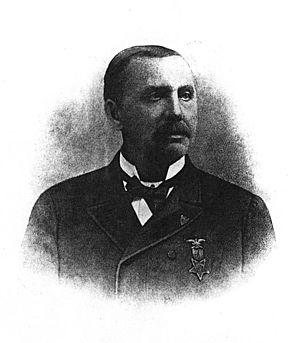Frederick William Fout facts for kids
Quick facts for kids
Frederick William Fout
|
|
|---|---|

Medal of Honor recipient Frederick W Fout c1896
|
|
| Born | October 1839 Meissen, Germany |
| Died | June 6, 1905 St. Louis, Missouri |
| Buried |
Bellefontaine Cemetery
|
| Allegiance | |
| Service/ |
|
| Years of service | 1861 - 1865 |
| Rank | Second Lieutenant |
| Unit | |
| Awards | |
Second Lieutenant Frederick William Fout (1840 to June 6, 1905) was a German soldier who fought in the American Civil War. Fout received the United States' highest award for bravery during combat, the Medal of Honor, for his action near Harpers Ferry in West Virginia on 15 September 1862. He was honored with the award on 2 November 1896.
Biography
Fout was born in Meissen, Germany on 1 October 1839 as Friedrich Wilhelm Fout. At about age 15 Fout left Germany for the United States where he stayed with an uncle in New Palestine, Indiana, anglicizing his name to Frederick William upon entry. A carpenter at the outbreak of the war, Fout first enlisted for a three-month service with the 7th Indiana Infantry Regiment in April 1861. After involvement in the Battle of Philippi (West Virginia), and the Battle of Laurel Hill his company was mustered out in August of that year. Fout re-enlisted into the Indiana Light Artillery. It was during his service in this regiment that he performed the act of gallantry that earned him the Medal of Honor. He was promoted to first lieutenant in January 1864 and put in command of his battery. In his personal papers, William Tecumseh Sherman mentioned that Fout's battery fired the first shell into Atlanta
Fout officially became a US citizen in 1865. Following the war, Fout moved to New York, where he married his former school teacher's daughter. After moving to Indianapolis, he started a glass manufacturing business. Several years later, he moved to St. Louis, Missouri, continuing his trade there. In his later life he moved into pensions and claims and also constructing houses. He died on 6 June 1905 and his remains are interred at the Bellefontaine Cemetery in St. Louis, Missouri.

